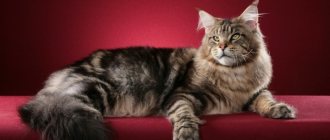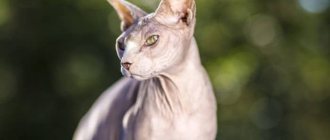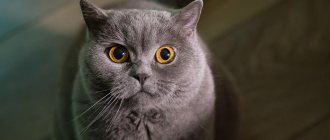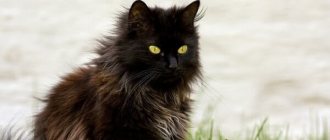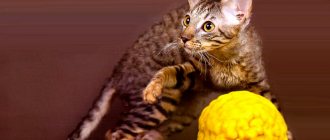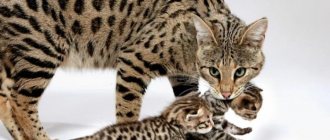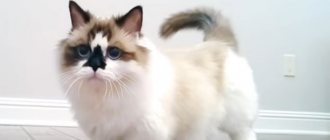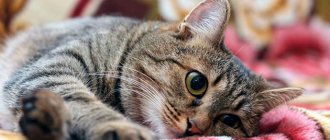Unremarkable at first glance, cats of the Li Hua Mao breed hide behind their modest appearance advantages that, without a doubt, are worth attention. These Chinese women are amazingly smart and calm, unpretentious in their care and endlessly devoted to their owner. Justifying the second name “Dragon Li” given by the people, the Mao are proud and original, and their hunting skills are not inferior to their fellow tigers.
Li Hua's Story
There is no reliable information about the origin of Mao, since their history goes back centuries. The Chinese themselves are convinced that the ancestor of the “Li Dragons” is the Chinese wild cat, which of its own free will became a favorite of the ancestors of the inhabitants of the Celestial Empire. Mentions of li hua are found in the chronicles of the 1st century, when the Tang dynasty ruled in the territory of ancient China. Then, according to the researchers’ theories, the range of the Li Mao’s habitat expanded, since every mid-level official could afford to acquire such a pet.
At home, the name of the Chinese breed does not coincide with the international “Dragon Li” and looks different - 狸花猫, which literally means “Fox flower cat”. It cannot be translated correctly.
The breed gained international recognition relatively recently - in 2005, after it was shown at an international exhibition in Beijing (December 30, 2003-January 6, 2004) as an experimental breed. In the history of the Li Hua, 2010 is marked by the registration of the breed by the association for breeding and developing new breeds CFA.
Breed Features
These cats were mentioned in ancient Chinese texts. Li huas appeared in China a very long time ago; the first mention of such animals dates back to the Tang Dynasty. In 2003, the breed was first demonstrated at an exhibition in Beijing. The standard was developed in 2005 and since then these cats have gained universal recognition. Today they are very rare and it is almost impossible to acquire such a pet.
Externally, representatives of this breed resemble an ordinary mongrel cat, but there are certain differences. The animal's physique is muscular and strong, but at the same time slender, the chest is wide, the back is straight. Size can vary from medium to large. Males weigh about 5 kg, females - 3.5 kg.
The paws are of medium length and strong. The forelimbs are the same size as the hind limbs, quite large and oval in shape. The tail is long and tapers towards the tip.
The head is elongated with a rounded forehead. The eyes are most often green or yellow, rather large and slanted. The ears are medium in size, slightly rounded at the ends. There are small black dots at the corners of the mouth, which create the effect of a smile. The nose is dark brown or black.
A distinctive feature of the Li Hua is their coat. It has a spectacular tiger color, silky and soft . The coat is quite dense, with a healthy glossy shine, the undercoat is weakly defined. Males have slightly coarser fur than females.
Only one color is recognized - brown tabi. There are black stripes in the shape of the letter “M” on the head, and dark spots on the abdomen. The tail is colored with dark rings, and the tip is completely black. There are continuous stripes on the chest that create a necklace effect. Stripes extend from the eyes and cheeks to the neck. The pattern must be clear and bright, and the wool must be ticked. The hair is black at the root, light in the middle, and brown at the tip.
These Chinese cats develop very slowly and reach full maturity only at three years of age. Therefore, they can only be transported after 12 months, since before that they are too weak.
The disadvantages of the breed are:
- Excess fat.
- Ears are too big.
- Disproportionately wide or narrow forehead.
- Fuzzy drawing.
- No necklace stripes on the chest.
- Not the black tip of the tail.
- Long wool.
Appearance
These animals have rather large and almond-shaped eyes.
The camouflage appearance of "Lee's Dragons" allows the cats to be invisible to unwary prey in the wild, but it appears deceptively generic to humans. However, Li Huas are not deprived of their own charm, and the Chinese cat breed standard is determined by the following parameters:
- The back is straight, the body is proportional and slightly elongated.
- The coat is dense, but soft and tactilely pleasant, the undercoat is poorly developed.
- The head is slightly elongated, the forehead is round. Due to the peculiarities of the color, it seems as if the cat is constantly smiling.
- The eyes are almond-shaped, large, and located at an angle. The color contrasts with the coat, mainly taking on shades of green and yellow.
- The ears resemble isosceles triangles with medium-sized rounded tops.
- The legs are muscular and straight. The hind ones are longer or the same length as the front ones. There are 5 toes on the front paws and 4 on the hind paws.
The color of the Chinese Li Hua cat resembles that of a tiger. Coal stripes dot the body, forming a necklace on the neck and chest, and unfinished rings on the paws and tail. There are dark spots on the pale belly. The background color of the coat is usually brown. The weight of "Lee's Dragons" does not exceed 6 kg for males, and for females it ranges between 3-4 kilograms.
Health, vaccinations and nutrition of Dragon Li cats
The health of Dragon Li cats is strong, since the breed was formed independently, without artificial breeding interventions. Wild Chinese mountain cats gave their descendants strong immunity and a long active life - up to 15-16 years. Of course, this does not mean that cats can be kept in a draft or frost; a weak undercoat will not allow them to retain their own warmth for a long time.
To maintain health, the animal should be promptly vaccinated against infectious and viral diseases. The first vaccinations are prescribed at the age of 3-4 months, repeated ones are given once a year. If a cat goes on a trip or changes its place of residence, a visit to the veterinarian and additional vaccinations are required.
The Chinese prefer to feed Dragon Li with ready-made dry food, which already contains all the necessary nutrients and vitamins. The best foods are considered to be those that have a premium class.
For those who prefer natural nutrition, it makes sense to familiarize yourself with some of the nuances. Li Hua is fed boiled sea fish and given lean meat (chicken, rabbit, veal, turkey), boiled offal, vegetables, and low-fat dairy products. Cereals are recommended for cats in limited quantities. A large amount of carbohydrates leads to obesity in the animal.
Since simple food does not have the full range of vitamins and minerals that cats need, give these complexes additionally. It is forbidden to feed cats from the owners' table: sweet, salty, spicy, fried foods and any seasonings are contraindicated for them.
Experts advise feeding adult cats and female cats twice a day at the same time, calculating the portion based on the weight of the animal. For 1 kg of weight you need 40 grams of natural food or 20 grams of balanced food.
Character and behavior
Such an animal can get along with another in the same territory.
Felinologists note that the Li Hua cat breed is distinguished by its versatile character, as if a peaceful, quiet dragon and a proud, predatory tiger coexist in one body.
The Mao's hunting skills are excellent, and they regularly demonstrate the ability to prey on annoying rodents, which is worth considering if you want to get a cat of this breed, already having a pet that risks becoming a victim of a predator. However, aggression is not characteristic of the Li Hua; the nature of these cats is calm and original. They share living space with other cats or dogs without any problems, although life is difficult for an active predator without personal space. “Dragon Lee” becomes attached to its owner strongly and for a long time; the cat needs the attention and care of a loved one, and in his long absence does not find a place for himself. Mao are smart and, due to their intelligence, are easy to train.
Character
Cats of the Li Mao breed are highly active and friendly. They do not show intrusiveness or aggression. They get along well with other animals... and, at the same time, are considered unsurpassed hunters - owners of pet rats, guinea pigs, hamsters, etc. need to take this into account.
It is better to have a pet of this breed in a house where there are no very small children (since “dragons” do not like excessive squeezing and caressing).
Also, Li Hua are very smart and loyal cats and are quite trainable. It is quite easy to train them to go to the litter box or sharpen their nails on a special scratching post.
The Li Mao breed is perfect for keeping in a small apartment. If the owners are on duty during the day, they can tolerate loneliness without any problems.
Hygiene and care
Such animals definitely need to buy a scratching post so that they do not damage the furniture.
To keep your pet clean, you should wash it 3 times a year. Depending on how much and often he gets dirty, the number of baths can be increased. The cat needs to be brushed twice a week, and during shedding, the fluffy Chinese Mao needs this procedure more often. Eyes and ears should also be cleaned weekly with cotton pads or a sterile wipe. It is important to provide your pet with a scratching post, otherwise he will use the furniture for the same purposes.
Feeding, care and health
Individuals of this breed do not require special care, as they have smooth, short hair. Combing the fur coat should be done no more than once every 7~10 days (you can use a rubber mitten in this process).
You should bathe your pet as needed (preferably no more than once a month) with baby shampoo or special cat shampoo.
Nails need to be trimmed once every 3~4 weeks (you need to cut off no more than two millimeters, since if you cut off more, you can hit a blood vessel and harm your pet).
Since the breed arose naturally, the cats are in good health and do not have certain genetic diseases. With proper care they can live up to twenty years.
There are no special recommendations for feeding Dragon Li. It is necessary to adhere to a balanced diet that includes all food groups. The fish must first be boiled, and it is preferable to give lean meat. Also sometimes needed: fermented milk products, cereals and vegetables.
The cat should always have fresh water in its bowl, which is especially important in the summer.
Dragon Li, Li Hua, or Li Mao.
Dragon Li. — description of the breed, character, price of kittens, video.
See other cat breeds here.
Story.
The cat breed Dragon Li, or Li Hua, or Li Mao (Dragon Li, Chinese Li Hua, Li Hua Mau, Li Hua Mao), has become widely known to cat lovers around the world quite recently, although mention of this cat is found in ancient manuscripts and historical documents, even from European countries. In China, this breed has been known since time immemorial and most likely arose through the domestication of the mountain cat. This breed was first exhibited in China, at the Beijing exhibition in 2003, and it was from that time that it began its history as an independent breed. But the Dragon Lee breed was officially registered only in 2010. Then breeders from other countries became interested in them and the breed received permission to export. Now Li Dragons are bred not only in China, but also in Europe and the USA. However, there is one caveat: these cats grow and develop very slowly. Dragon Li becomes an adult only at the age of three. Therefore, kittens before they reach twelve weeks of age are not sold, since they are still too weak and cannot be transported.
Appearance.
It must be said right away that Dragon Lee, at first glance, looks like a simple mongrel cat. But, like all officially registered breeds, Li Hua has its own standards. The body of these cats is strong and muscular. The back is straight. The front and hind legs are of equal length, but it is acceptable for the hind legs to be slightly longer than the front ones. The head with a round forehead has an elongated shape. There are black dots at the corners of the mouth that create the illusion of a smile. This is a mandatory requirement of the standard. The ears are wide, slightly rounded. The tail is long, tapering towards the end. The eyes are almond-shaped, slightly slanted. The outer corners of the eyes are always higher than the inner ones, which is also a distinctive feature of the breed. Eye color: yellow or green. The Dragon Lee has almost no undercoat, but the short but dense fur itself is two-layered.
Males have a coarser coat than cats, whose coat is more soft and silky. The coat color is brown tabby, with black stripes throughout the body, paws, tail and head. There is always one black stripe on the chest in the form of a necklace of no particular shape.
Character.
Smart, calm and affectionate cats. They get along well not only with people, but also with other animals. They quietly remain at home alone. It’s just that it’s a bit difficult for them to live in a house with children. These cats are not very playful and do not like excessive petting and squeezing. It is noted that Dragon Lee is easy to train. Cats are very smart and at the same time very loyal to their owners.
Care and health.
Since this cat came from wild ancestors, she has excellent, good health. Li's dragons rarely get sick, are hardy and are not picky about food and maintenance. Their care is minimal. Tray, scratching post, balanced diet, comb once a week and bathe once a month. Which, of course, does not cancel mandatory vaccinations and preventive visits to the veterinarian. He will tell you how often to visit the doctor himself.
Price for a kitten of the Dragon Lee breed.
Although these cats have existed for centuries, or even a millennium, as a breed, they were officially registered recently and are extremely popular. Again, they grow up slowly. So the price for these kittens is steep, from $500 to $800, depending on the reputation of the club, breeder and pedigree.
Dragon Lee: description of the breed.
(Alas, only in English.)
See other cat breeds here.
Go to Main page.
The sad story of the Chinese cat
The careful Chinese gave this animal its name, which, however, does not characterize either the animal itself or its way of life: “huang mo mao” is translated as “a cat that lives in a desert area with sparse vegetation.”
This "desert" cat is never found in the desert
Although, if you consider that the Chinese mountain cat is practically never found in deserts, then its second official name, the Gobi gray cat, also sounds very strange. For some reason, this is how it happened historically, but in the last 25–30 years, the name “Chinese mountain cat” has become commonly used for the species Felis bieti, which more accurately reflects reality.
Habitat and role in the ecosystem
Despite the fact that this wild cat is considered endemic to China and most of its population is spread throughout Chinese territory, the animals are sometimes found in Tibet and southern Mongolia. Basically, the animal lives in vast areas of the Chinese provinces of Sichuan, Qinghai and Gansu, as well as in the autonomous regions of Ningxia Hui and Inner Mongolia. These regions are distinguished by a harsh, sharply continental climate, but the wild cat has adapted well to it; she even lives in the mountains at an altitude of up to five kilometers.
The Chinese mountain cat is well adapted to abnormally harsh climates
Since the basis of the animal’s diet has always been small rodents, its important role in the ecosystem was also associated with their destruction. But as often happens, a person rudely and thoughtlessly intervened in the situation. In China, for twenty years, from the late 50s to the late 70s, a large-scale campaign to combat field pests continued - they were poisoned with powerful poisons, in particular zinc phosphide. During this period, along with rodents, a huge number of wild cats also died. This was finally the reason for the end of many years of persecution.
The habitat of the Chinese cat is unique, as is the animal itself.
Economic activities leading to the destruction of the hunting grounds of the Chinese cat, as well as poaching of the animal - mainly for its beautiful skin - have led to a sharp decline in the number of an already rare species. Its population today does not exceed 2.5 thousand adult individuals.
The CITES Convention significantly limits the international trade in animals of this species, which, however, does not prevent the Chinese from selling both wild cats themselves and products made from their fur in the markets - national hats made from the skins of this animal are still popular in the country. The endangered species is listed in the International Red Book. The population size is decreasing year by year, and this dangerous trend can lead to the complete extinction of the species.
Chinese cat skins are still a hot commodity
In addition to humans, there are other enemies of a wild cat - these are larger predators, bears and wolves that hunt its cubs.
Video: Gobi gray cat - endemic to China
Habitat
They live in alpine meadows, steppe pastures, mountain shrublands, and on the edges of high-mountain coniferous forests from 2500 to 5000 meters above sea level. Their dense fur helps them withstand extreme mountain climates. Although Felis bieti is sometimes called the "Chinese desert cat", this species does not live in desert areas.
